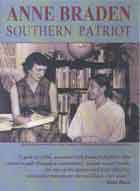
Anne Braden Southern Patriot 2012
Distributed by California Newsreel, Order Dept., PO Box 2284, South Burlington, VT 05407; 877-811-7495 (toll free)
Produced by Anne Lewis and Mimi Pickering
Directed by Anne Lewis and Mimi Pickering
DVD, color, 77 min.
Jr. High - General Adult
African American Studies, American Studies, Film Studies, Gay and Lesbian Studies, History, Human Rights, Law, Philosophy, Political Science, Social Work, Sociology
Date Entered: 01/22/2013
Reviewed by Jennifer Dean, MALS student, City Univerity of New York (CUNY Graduate Center)In the introduction to the documentary Anne Braden Southern Patriot, while speaking to a classroom full of students, Braden remarks that a documentary is being made of her, “which embarrasses me highly.” Braden elucidates, “People are more interested in people than ideas initially” but in the end she claims, they will be interested in the ideas. Not only is this an astute observation of many a documentary from the very beginning of the art form with Nanook of the North, but it is also a window into the success of this particular documentary.
Braden is an incredibly compelling subject and her work in the civil rights movement and her struggles with the House Un-American Activities Committee brings to light the history of several groups and philosophies in the United States. As a white woman raised in the South Braden grew up with one outlook on the world and race relations and then after University and working as a journalist she became active in the fight against segregation and racism and expanded her view of her position in society. Having a unique perspective, she understood that equality is important not only for black Americans but also for white Americans and fought to reveal this reality to other whites.
The movie delves into personal tragedies as well as professional accomplishments in Anne Braden’s life. Which, of course, in the case of a community activist such as Braden are inextricably linked. One such example is when the Bradens decide to help a black family, the Wades, buy a home in the suburbs of Chicago. The Wades are told by a real estate agent the only way they will be able to purchase a home in a white neighborhood is if they find a white representative willing to stand in for them. Braden and her husband represent the Wades in the transaction and purchase the house for them, eventually leading to their arrest for sedition.
Directors Anne Lewis and Mimi Pickering intertwine interviews from various subjects, including several interviews with Anne Braden directly, to tell the story of her life. The documentary would benefit from additional archival footage and more b-roll footage but the breadth of the subject matter and the depth of the subjects make up for the limitations in footage. There are, however, a few wonderful home movies and news pieces from the Bradens’ legal battles and insightful interviews with and speeches from iconic civil rights activists and intellectuals such as Angela Davis and Cornel West, fleshing out both the story of her life and how it relates to race relations and class issues in the United States. The DVD includes Wasn’t That a Time a short film on three victims of the House Un-American Activities Committee originally released in 1961. The film would be an excellent asset to a study on the civil rights movement as well as an excellent study for a course on the art of documentary filmmaking.